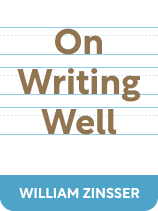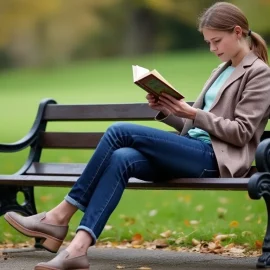

This article is an excerpt from the Shortform book guide to "On Writing Well" by William Zinsser. Shortform has the world's best summaries and analyses of books you should be reading.
Like this article? Sign up for a free trial here .
What makes a good story? What are the key elements of a story that’s enticing and compelling to read?
It’s one thing to be a good writer, but it’s another thing to know how to write a good story. To keep your readers’ attention throughout the piece, the beginning, middle, and end of a story should flow together logically and coherently.
Here are some tips from writer and journalist William Zinsser.
How to Structure a Story
In his book On Writing Well, writer and journalist William Zinsser explains how to write the beginning, middle, and end of a story. Here are his tips:
Write a Compelling Lead
Zinsser believes that deciding how to start a piece is one of the most difficult decisions you’ll make when writing. The first sentence—known as your lead or lede—is your most important one. Your lead should capture your reader’s interest and compel her to keep reading. Give your reader enough information to keep her interested, but don’t spoil your whole story—otherwise she won’t have a reason to keep reading.
He explains that a lead can look different depending on the story and the writer. Some leads may last a paragraph or a page. Others might only take a few sentences. But Zinsser believes shorter leads are more impactful—the faster you can hook a reader’s interest, the faster you can move on and discuss your ideas or topic.
| Avoid These Types of Leads Zinsser admits that there are many different ways to write a good lead, and other writers echo this claim. It can be helpful to know which kinds of leads to avoid, so you can focus on writing one that’s compelling. For a strong lead, avoid these common pitfalls: Clichés and bad puns. Not only do these make your reader roll their eyes, but they’re also not a tasteful way to start your piece. For example, a Huffpost article started with this pun: “Authorities did Nazi this coming.” Long sentences. The lead isn’t the place to explore too many ideas or tangents—you have the rest of your story to do that. Trying too hard. Don’t try to sound too clever or funny because you’ll wind up losing your reader’s interest if they have to figure out your meaning. This tactic also overpromises—usually a piece with a too-clever lead doesn’t have very clever ideas. Saying someone “could never have predicted.” This isn’t an informative or interesting way to start a piece because we rarely make accurate predictions about what will happen to us. The weather. Usually commenting on the weather doesn’t add interest or meaning, so don’t describe it in your lead. |
Vary Your Paragraph Length
Once you effectively hook your reader with a compelling lead, the next key step is to keep their attention through the body of your piece. Varying your paragraph length can help you do this, setting the pace of your writing by using both long and short paragraphs.
Zinsser explains that some paragraphs will naturally be longer than others—maybe you’re giving more detail in this paragraph. But if you make all of your paragraphs too long, you’ll lose your reader’s attention in a sea of words. Other paragraphs will naturally be shorter—maybe you’re recounting action and want to create a sense of urgency. But if all of your paragraphs are too short, your piece will feel choppy and disjointed.
(Shortform note: If you’re struggling with your paragraph length, include a topic sentence at the beginning of every sentence. A topic sentence will discipline you to discuss only one main idea in each paragraph, thus guiding the discussion. When you move on to a new idea, start a new paragraph. Some ideas will take longer to discuss, resulting in longer paragraphs, while others will only take a few sentences or less. By using topic sentences, you’ll naturally vary your paragraph length.)
End a Story
Once you’ve crafted a compelling lead and kept your readers’ interest throughout the body of your piece, you’ll need to end your story, which is your final impression on your reader. So how and when should you end your story?
Zinsser advises ending a story as soon as your piece is fully developed. If you stretch your story out beyond this point, you’ll find yourself exploring the same themes and summarizing what you’ve written, which is repetitive. The body of your story already told your reader the information she needed and you don’t have to repeat it to her.
However, don’t leave your reader unsatisfied by cutting your piece too short without fully exploring a topic. Zinsser believes that if your piece is underdeveloped, you’ve wasted both your time and your reader’s.
To end a piece, encapsulate the main idea of the story without summarizing the whole thing. Zinsser has a few suggestions:
1) Bring the story back to where it started. Reference an idea you introduced at the beginning of the piece, or use a quote that encapsulates the overall idea of the piece.
2) End the story with a surprise. Add an unexpected element, like a joke or an odd detail, that still encompasses the main idea. For example, in “Meditations on the Harp,” M. G. Stephens ends his piece with this sentence: “On the way back to the motel on the beach, I buy a pair of cross-training sneakers at a factory outlet, I eat McDonald’s french fries and some chicken fajitas, I wonder why I have yet to taste a good orange or drink some fresh-squeezed orange juice, or why I imagine that I am feeling nothing about being on the Gulf Coast of Florida, and even less about my father’s death.” These last seven words are in stark contrast to the rest of the sentence, offering the reader a surprise.
| Other Ways to End a Story Writer Bruce DeSilva notes that there’s a lot that an ending must do: tell your reader the story is over, emphasize your main idea, make your reader think even after finishing the piece, and occur at the right time. He also believes truly great endings have an element of surprise. Other experts offer advice on the specific kinds of endings for nonfiction: 1) The Lesson Learned: If the purpose of your essay is to share a new understanding or realization, try ending with the lesson you learned. But be sure not to preach or talk down to your reader when relaying the lesson. 2) The Lyric Moment: This is an ending that uses a poetic structure of words, repetition, or meter to create a lyrical effect. For example, Don Tate ended his book with the lines, “George’s love of words had taken him on a great journey. Words made him strong. Words allowed him to dream. Words loosened the chains of bondage long before his last day as a slave.” The repetition of “words” at the start of each sentence creates a lyrical pace and poetic effect. 3) The Open Ending: This is the kind of ending that is up to the reader’s interpretation. There are multiple ways your reader could understand the ending, usually leaving her with questions. 4) The Circle Back: In this ending, your ending connects back to the beginning of your piece. This makes your writing feel complete, even if you didn’t provide any kind of solution or lesson. 5) The Abrupt Ending: This ending occurs after building the momentum of your piece. You end your piece unexpectedly, rather than gradually drawing it to a close. But be careful when using this ending—your piece shouldn’t feel unfinished. |

———End of Preview———
Like what you just read? Read the rest of the world's best book summary and analysis of William Zinsser's "On Writing Well" at Shortform .
Here's what you'll find in our full On Writing Well summary :
- A back-to-basics approach to the craft of writing
- How to practice simple, clear, and engaging writing—even if you're not a writer
- How to effectively put your ideas into words






